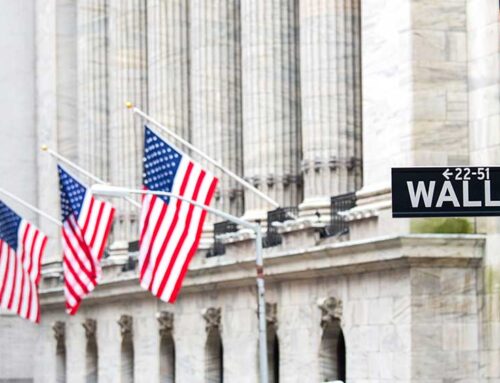Trump tariffs: What’s the impact on renewables?
May 14, 2025
US President Donald Trump has long made his thoughts on wind energy known. But in a recent speech in Michigan marking his first 100 days in office, he made it plainer than ever before.
Commenting on his support of coal-fired power plants, he added: “You know what I don’t give approval to? Those stupid windmills that go round and round.”
It marks the latest in a number of attacks the president has made on the clean energy industry since entering the White House — with much of that focused on wind.
On his first day in office, President Trump signed an executive order halting permits for onshore wind energy projects and leases for offshore wind farms in US coastal waters.
It’s taken a toll on forecasts for the sector, with a recent Bloomberg NEF report projecting lower growth by the middle of the next decade, “reflecting the administration’s actions on permitting and seabed leases”.
It has investors and those working in the sector worried, says Hannah Hess, associate director on energy and climate at independent research provider the Rhodium Group.
“When you’re seeing hostility towards a certain type of clean technology from the administration, understandably the people who are developing both wind projects and the manufacturing of components like blades and towers are deciding that maybe now is not the right time to build one of these facilities in the US,” she said.
And that’s despite the incentives currently in place through the Inflation Reduction Act (IRA), she added.
The clean energy boom in the US
Clean energy in the US has grown significantly in recent years. In 2024, more than 90% of new energy capacity came from wind, solar and battery storage, a figure that was boosted by investment through the IRA.
Passed in 2022, under the administration of then-President Joe Biden, it was the biggest climate investment in US history. The former government pledged to invest $370 billion (€330 billion) over the next decade to boost clean energy technology and reduce greenhouse gas emissions.
“That was a really exciting point of growth to see, and I think part of that is that the costs have just come down for these clean tech generators,” said Leslie Abrahams, deputy director of the Energy Security and Climate Change program at the nonprofit policy research organization Center for Strategic and International Studies.
“Part of that has been from the IRA tax credits,” she added.
Overall, renewables now account for more than 20% of electricity generation in the US, with wind making up almost half of that. And while it took 40 years to build capacity for utility-scale clean power to 200GW, another 100GW was added in just three years, marking a “dramatic acceleration”, according to report from clean energy industry body the American Clean Power Association.
As demand for electricity in the US grows for the first time in more than a decade, reflecting the needs for data centers, and expanding manufacturing sector and increasing electrification for electric vehicles, for example, more power than ever is needed, say analysts.
“We are really trying to get ahead of that problem and make sure that we have enough generation capacity on the grid and the manufacturing side,” said Abrahams, adding that she believes clean energy is the key.
“Clean energy is the fastest to get online,” she said.
The impact of tariffs on the renewable sector
But it is in contrast to the beliefs of the new president. Even on the campaign trail, Trump promised more investment in fossil fuels, proclaiming his now-infamous slogan to “drill, baby, drill”.
Since taking office, the Trump administration has tried to stop funding already approved for green energy projects and threatened to repeal parts of the IRA.
In early April, the president proposed tariffs that in the long run could also have an impact on the clean energy industry — particularly those targeting Southeast Asia, a region where countries are facing some of the highest figures.
“Tariffs on Southeast Asia would have a quite dramatic impact on solar, in particular in the US, because some of those earlier-stage components that are critical inputs to our already quite developed solar module manufacturing sector would now be subject to high tariffs,” said Hess from Rhodium.
“There isn’t one clean energy that doesn’t rely on imports,” added Abrahams.
If put in place, the tariffs could mean companies developing renewables — but also natural gas, for example — end up paying much higher prices, and that could have a trickle-down effect, said Abrahams.
“My concern is that that’s going to get passed on ultimately to the customers, to the ratepayers, at a time when affordability is a key issue in electricity,” she said.
Although the president has since put the brakes on many of the tariffs for 90 days, that, along with the funding freezes and anti-renewables rhetoric, is “injecting uncertainty into the future trajectory of the place for clean tech in the United States,” she added.
In the first quarter of this year, before Trump had made his initial tariff announcements, six clean energy projects, representing $6.9 billion (€6.2 billion) of investment, were cancelled, according to Rhodium’s Clean Investment Monitor, “the highest quarterly value on record”.
The situation is “nuanced,” says Hess, adding there had also been a high number of new manufacturing projects announced, up from the last quarter of 2024, but lower than the same period last year.
“The uptick in new announcements, coupled with significant cancellations, highlights both the progress achieved under the IRA and the risks posed by an unstable policy environment,” reads the Rhodium report.
Clean energy will continue to grow, but at a slower pace
Despite the headwinds facing the clean energy industry in the US, the consensus is that the sector will continue to grow, albeit at a slower pace. Experts at Bloomberg NEF’s New Energy Outlook predict that wind capacity will double by 2035 and solar will triple, while battery storage will increase from 29GW in 2024 to 175GW.
Still, the US will have to compete globally as countries all over the world move away from fossil fuels and look to cleaner energy sources.
“Ultimately, I think there’s so much momentum behind clean tech right now. It’s not just about climate, it’s really about economic competitiveness, geopolitical leverage and national security,” said Abrahams.
She added that if the US continued to isolate itself, the sector would push ahead without US involvement.
Edited by: Sarah Steffen
Search
RECENT PRESS RELEASES
Related Post




